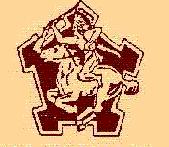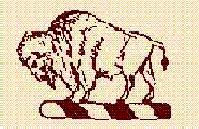

Black soldiers fought in Washington's army during the War of Independence, and served with Andrew Jackson at New Orleans in 1815. Late in 1861, Colonel T. W. Higginson took command of the First Regiment of South Carolina Volunteers, the first Black regiment in the service of the United States.
On June 28, 1866, an Act of Congress authorized the creation of six regiments of Black troops, two of cavalry and four of infantry. These troops went on to play a major role in the history of the West, as the "Buffalo Soldiers."


For more then 20 years, the 9th and 10th Cavalry Regiments served on the frontier from Montana to Texas, along the Rio Grande in New Mexico, Arizona, Colorado, and the Dakotas. They built forts and roads, strung telegraph lines, protected railroad crews, escorted stages and trains, protected settlers and cattle drives, and fought Cheyenne, Arapahoe, Kiowa, Comanche, and Apache warriors, among others. Dangers such as cholera and rabid wolves sometimes took more lives than Indian warfare.
The Plains Indians began to call the Black cavalrymen "Buffalo Soldiers" and the troopers accepted the title and wore it proudly. To be associated with the fighting spirit of the Indian's sacred buffalo was a measure of respect.
In 1875-76, the 9th Cavalry Regiment was transferred to the New Mexico District, under command of Colonel Edward Hatch. Two companies were stationed at Fort Bayard, one at Fort McRae, two at Fort Wingate, three at Fort Stanton, one at Fort Union, one at Fort Selden, and one at Fort Garland. In New Mexico, the Buffalo Soldiers participated in campaigns against Victorio, Geronimo, and Nana.
In 1877, a scouting party from Fort Bayard commanded by Lt. Henry Wright, with six men of Company C and three Navajo scouts, was surrounded by a party of 40 to 50 Chiricahuas in the Florida Mountains, near Deming, New Mexico. "Weapons were fired and then used as clubs. In the center of the melee Corporal Clifton Greaves fought like a cornered lion and managed to shoot and bash a gap through the swarming Apaches, permitting his companions to break free....Corporal Greaves was awarded the Congressional Medal of Honor." (From The Buffalo Soldiers by William H. Leckie, Univ. of Oklahoma Press)
The conditions the Buffalo Soldiers fought in, while pursuing the Apache, are described in a letter from Colonel Hatch to General Pope, "...the work performed by these troops is most arduous, horses worn to mere shadows, men nearly without boots, shoes and clothing. That the loss in horses may be understood when following the Indians in the Black Range the horses were without anything to eat five days except what they nibbled from piņon pines, going without food so long was nearly as disastrous as the fearful march into Mexico of 79 hours without water, all this by forced marches over inexpressably rough trails...It is impossible to describe the exceeding roughness of such mountains as the Black Range and the San Mateo. The well known Modoc Lava beds are a lawn compared with them." (Hatch to Pope, February 25, 1880)
On September 18, 1879, troopers from Companies B, C, E and G of the 9th Cavalry were ambushed by Victorio, War Chief of the Warm Springs Apaches, at Las Animas Creek in the Black Range of New Mexico. Conflicting reports put the number of troopers killed at either five or six, along with either two or three Navjo scouts. Several troopers were awarded Congressional Medals of Honor, after saving wounded troopers. (From Ambush In Massacre Canyon by Gene Ballinger, The Courier, July 29, 1993).
Elements of the 9th and 10th went on to fight in Cuba, and took part in the charge up San Juan Hill. The 10th Cavalry took part in the expedition against Pancho Villa, with General Pershing. The two regiments were formed into the 4th Cavalry Brigade in 1941, commanded by General Benjamin O. Davis, Sr., at Camp Funston, Kansas. The horse cavalry regiments were disbanded in 1944, and with them, the long and proud history of The Buffalo Soldiers.
The 9th and 10th (Horse) Cavalry Association holds annual reunions at different locations throughout the nation. Associate membership is extended to any person who has rendered outstanding service to the association or the the United States through service either in the Armed Forces or their community
A message from J. J. Johnson
Black Co-Founder of The Ohio Unorganized Militia